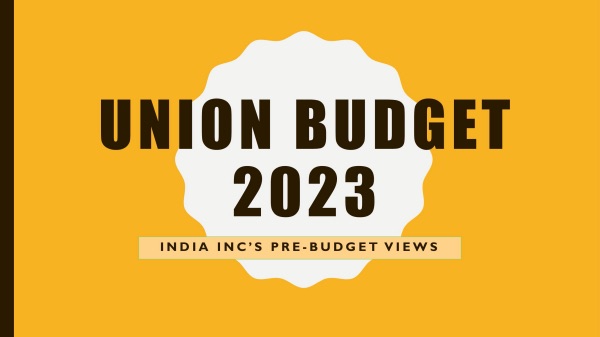India Inc. leaders spoke to Estrade on their pre-budget expectations

Kaushal Agarwal, Chairman, The Guardians Real Estate Advisory
The central government has done a lot of work for the real estate sector with landmark initiatives in the years 2021-2022, one of which was affordable housing, also known as Pradhan Mantri Awas Yojana (PMAY). The sector has pinned its hopes on the upcoming Union Budget, expecting continued support through provisions that will benefit not only the real estate sector but the entire country’s economy.
Expectations from the Union Budget 2023-24:
● The industry requires a single window clearance to streamline and expedite the process as the average number of permissions required by developers exceeds 50, and the process typically takes good time.
● To attract homebuyers from across the country, particularly first-time buyers, the government should raise the tax deduction limit for home loans from 2 lakh to 5 lakh per year, thereby providing tax relief to homebuyers.
● The real estate industry will be able to draw equity investment, restructure its debt, and get loans at cheaper interest rates with the support of a long-pending request for ‘Industry’ status.
● Prices have risen due to ongoing crises, so we expect announcements on specific schemes such as a reduction in GST on under-construction properties and pricing of key raw materials in the Union Budget 2023-24.
● The emphasis should be on increasing investments in green infrastructures such as renewables as well as traditional infrastructures such as roads, railways, and ports.
Sanjana Desai, Executive Director Mother’s Recipe
“We anticipate many populist changes in the upcoming budget keeping in mind the Indian consumer and their expectations. The government has always been supporting rural growth in the past and we expect this to be enhanced further this year along. We are optimistic and hope for the rural market to bounce back in 2023. Last year many emerging channels like modern trade and e-commerce were seen driving urban demand, and this led to the rise in premium discretionary categories. The FMCG industry witnessed a seismic shift in omnichannel growth with sales significantly outpacing in-store growth across metro cities, we expect the trend to continue. This year the strategy will be to focus on new products and consumer experience innovation.”

Ashwin Reddy, Managing Director, Aparna Enterprises Ltd.
“Building materials industry bounced back to pre-covid levels in 2022 registering around 10% growth owing to increased push for infrastructure development and upswing in the real estate sector. The trend is expected to continue in 2023 as well. We believe that upcoming union budget will continue to see heighted allocation for infrastructural development which in-turn will benefit the building material industry. However, the industry is reeling under the burden of rising cost of raw materials, delayed projects owning to cash crunch, clearance issues and supply chain disruption. Tax slab rationalization for essential building materials, incentivization of sustainable products and interest subsidy for MSME Players can go a long way in boosting the sector while inflation is arrested with a slew of interventions.”

Dr. Alok Khullar, CEO, Gleneagles Global Health City, Chennai –
Covid19 exposed the vulnerabilities in our healthcare delivery system and overall Healthcare Industry. Our government is considering several measures for the overall economy to recover. Industry experts suggest a multi-pronged approach to strengthen healthcare delivery & outcomes. The approach includes focus on budgetary allocation and focus on enhancement of capacity in the following areas:
- Medical Education: In recent years, many additional medical colleges are being set up increasing the number of doctors passing out. However, a critical area for improvement is the quality of medical education and hands-on training for these doctors to be job ready to deliver patient care at a minimum standard. In addition to attracting the right faculty, there must be investments in building skill labs across medical colleges and standardizing the assessment criteria and framework.
- Healthcare Infrastructure: Expanding bed capacity is not enough as the quality of care delivered depends on multiple factors including the type of bed capacity (Ward vs ICU), medical equipment, Oxygen supply, and Supply chain efficiencies among multiple other factors. The private sector plays a huge role in providing tertiary & quaternary care and thus should get the adequate financial impetus to enhance its capacity. Hospitals, in particular, get economic SOPs like Special Economic Zones do to develop and deliver care at an effective cost for patients.
- Nursing & Allied Healthcare Staff Education & Training: The nursing workforce in India has one of the highest attrition rates in the country as they go overseas for better financial remuneration and quality of life. There must be sustained investments into improving the quality of Nursing Education and hands-on training in the existing Nursing colleges to have a job-ready workforce to replace the exodus of trained nurses from India. A similar focus is needed in Allied & Paramedical Staff education & training.
- Medical Equipment: Most of the high-end Diagnostic, Imaging, Intervention, Precision, Monitoring & Surgical equipment are manufactured abroad and imported to India and come at a huge cost to Healthcare Providers. The industry requests the Government to invite Global Medical Equipment Manufacturers to set up factories in India under “Make in India” to lower the cost of production and therefore price and provide employment to millions of Indians.
- Research & Development: Healthcare Research in India is limited and needs sustained support from the Govt to enhance and increase the R&D efforts and sell the successful results to the entire world. As of now very few Innovator molecules if any are researched & developed in India. The same goes for precision surgical instruments.
- Healthcare Financing: Considering the rising cost of healthcare, it is essential to have health insurance for every family. Unfortunately, one has to insure a vehicle mandatorily to drive on roads but the driver and passengers don’t have to have health insurance. The government should provide better financial incentives for people to buy health insurance and make it mandatory for people above the poverty line to reduce the financial burden on household savings because of illness. Further impetus is needed for the development of the health insurance industry.

Jigish Doshi, President, Plastindia Foundation, pre budget views:
Plastindia Foundation urges the government to lower the import on polymer and increase the custom duty on finished plastic products in Union Budget 2023-24 to support the domestic plastic industry
Finance Minister Smt. Nirmala Sitharaman is all set to present the Union Budget for the financial year 2023-24.Plastindia Foundation is hopeful that the hon’ble Finance Minister will frame the budget keeping in mind the overall growth and development of the entire plastic industry – from raw materials, and converter to machinery manufacturers. Plastindia Foundation’s motto is to put the Indian plastic industry on a high growth path – from USD 5 trillion in 2025 to an ambitious USD 25 trillionby 2045.
To drive this growth and to make India the global sourcing hub for plastic,Plastindia Foundation wholeheartedly supports the Make in India andAatmanirbhar Bharat initiatives.However, we need support from the government to make this a reality:
Ø The import duty on polymer should bebetween 5 – 7.5 %. India does not produce enough polymer and import is inevitable. Import duty on polymer needs to be lowered to make the Indian plastic industry more competitive
Ø Custom duty on the finished plastic product should bea minimum of 20% or moreto support the domestic plastic processing industry
Ø The government is focusing on renewable energy, and this presents an opportunity for the plastic industry. However, at present90% of the components for solar panels and windmills are imported and the products are only assembled in India.Toencourage the local manufacturers, thecustom duty on the import of components likeEVA, back sheet, metal frame, solar glassetc., should be at least20%.The plastic industry can play an important role in manufacturing EVA and back sheets
To promote industrialization in India, I would also request the hon’ble Finance Minister to consider the following:
Ø Make uninterrupted power available at less than Rs 5 per unit. India has a high electricity rate and power fluctuation is also very high. This rate is at par with neighbouringcountries that makes uninterrupted power available to industries at a low cost
Ø India should have a free labour law however the wages should not be so high that it makes the manufacturing industry globally uncompetitive.Labour law should come under the purview of the Central government and wages across the country – in tier 1, tier 2 and tier 3 cities, should be uniform
Ø GST should not be higher than 12% across product categories
Ø Government should make land acquisition easy by identifying zones of land that are non-agricultural.Land from those zones should be made available easily without industries having to go through the formality of converting agricultural land to non-agricultural land. Also, the Government should start a new formula wherein developed land should be made available to industries on long-termleases. This will significantly lower the investment on land and make Indian industries globally competitive. Currently, the price of land is so high that project costsskyrocketed.China is using this formula for a very long time
Ø Easy financeat reasonable interest rates from both banks and NBFCs should be made available to the industry
Ø Compliances should be kept minimum. Also, if there areany technical errorsin following these compliances then it should be handled by a separate court. It should not be treated as criminal activity
Overall, we are expecting a budget that is industry-friendly and makes the domestic plastic industry more dynamic and globally competitive.
About Plastindia Foundation:
Established in 1987, PLASTINDIA FOUNDATION is the apex body of the major association, organizations, and institutions connected with Plastics focused to promote the development of the plastics industry and assist in the growth of Plastics and related materials. The Foundation is committed to the nation’s growth through the development of the Plastics sector. The aim of the Foundation is to facilitate the export-led growth of the Indian Plastics industry and help boost exports both in volume and revenues. It aims to make India the number one destination and the preferred sourcing base of Plastic products in the world







